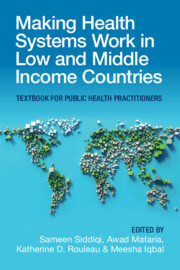 Making Health Systems Work in Low and Middle Income Countries
Making Health Systems Work in Low and Middle Income Countries Fault Lines Exposed and Lessons Learned
from Section 2 - Transforming Health Systems: Confronting Challenges, Seizing Opportunities
Published online by Cambridge University Press: 08 December 2022
The COVID-19 pandemic has demonstrated that: 1) there is no single ‘cookie-cutter approach’ to health systems strengthening, and 2) health systems must be significantly more holistic and equitable. This chapter examines the global spread of COVID-19 and its impacts on health systems and communities. By analysing public health gaps and challenges in L&MICs, the authors provide concrete examples of innovations and interventions that were effective in responding to the pandemic. It explores how different health systems across L&MICs and HICs can be better equipped to mitigate health emergencies and maintain routine health services by leveraging a range of essential public health functions, primary health care, and risk management capacities. Health systems resilience is only possible when systems thinking is operationalized and aligned with the wider SDGs. There is a case for multisectoral engagement in mounting a comprehensive health systems response to COVID-19 at the national and global levels. The chapter offers lessons on why strengthening health systems -- through integrated investments and with equity and resilience as key objectives – is key to sustainably achieving health security and universal health coverage.
To save this book to your Kindle, first ensure [email protected] is added to your Approved Personal Document E-mail List under your Personal Document Settings on the Manage Your Content and Devices page of your Amazon account. Then enter the ‘name’ part of your Kindle email address below. Find out more about saving to your Kindle.
Note you can select to save to either the @free.kindle.com or @kindle.com variations. ‘@free.kindle.com’ emails are free but can only be saved to your device when it is connected to wi-fi. ‘@kindle.com’ emails can be delivered even when you are not connected to wi-fi, but note that service fees apply.
Find out more about the Kindle Personal Document Service.
To save content items to your account, please confirm that you agree to abide by our usage policies. If this is the first time you use this feature, you will be asked to authorise Cambridge Core to connect with your account. Find out more about saving content to Dropbox.
To save content items to your account, please confirm that you agree to abide by our usage policies. If this is the first time you use this feature, you will be asked to authorise Cambridge Core to connect with your account. Find out more about saving content to Google Drive.